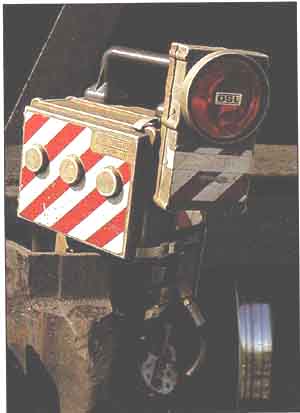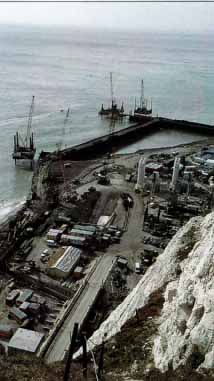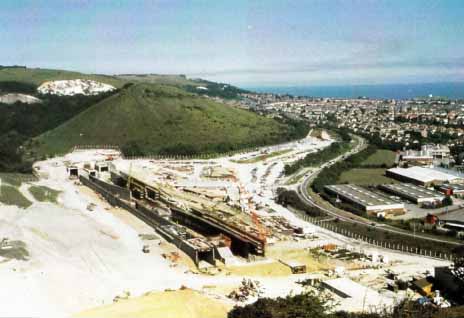What's a "Double-stack Train"?
The 1980s saw great change in the American railroads. As truckers took more and more of the general merchandise hauling away from the rails, the railroads’ early response was the “piggyback” train, where truck trailers were loaded onto special flat- cars and then picked up at the terminal to continue the road haul.
As merchant shipping became containerized, and intermodal freight was deregulated by the Staggers Act, the railroads continued to adapt with new marketing strategies.

At the beginning of the decade, watching a
Union Pacific hotshot “piggy back” climbing Cajon Pass meant an end-
less parade of Trailer Train flatcars with mostly 40-foot (12 m) highway
trailers mixed in with a few 45-foot (14 m) trailers and some containers.
Ten years later, even the name “piggyback” is anachronistic; a solid
train of “double-stack” container cars is the norm.
In addition to the equipment change, the international container shipping lines have entered the picture as “hands-on” customers of the railroads. These companies sell their services directly to the shippers, and then contract with the railroads for hauling the load, as opposed to the traditional contract being between the rail road and the shipper. The primary traffic is from Southeast Asia into West Coast American ports, and thence is distributed eastward via rail. Train capacity can be topped off with domestic traffic, and westbound loads can be used to minimize empty back hauls.
American President Lines was the first shipping line to contract with the railroads to operate a containerized unit train with its own equipment. The cars were all- purpose 89-foot (27 m) hitch/container flats leased from Itel Corp. Sea-Land also operated unit trains, but with equipment from the Trailer Train Company. As the traffic volume increased, so did the need for specialized equipment. Price sensitivity of this highly competitive business meant that all possible efficiencies had to be explored: thus the evolution of the double-stack container car.
The double-stack car was developed by the team of Sea-Land, Southern Pacific, and ACF Industries; the first was SP 513300, built in July 1977. Basically a well hole flat, it allowed the container to fit into the car, between the side frames, so that a second container could fit on top without overhead-clearance problems. A triple- platform car, the first articulated double- stack, followed in 1979. Satisfied with the prototypes, SP ordered 42 five-unit articulated double-stack cars from ACE Each group of cars weighed 199,100 pounds (90,390 kg) and carried the bottom container 14 inches (35 cm) above the rail.
|
In 1983, the Thrall Car Corporation built a three-platform prototype double stack car with interbox connectors to secure the upper container to the lower, thus eliminating the heavy bulkhead formerly used. Delivery of 86 five-unit articulated versions of these cars to American President Lines signaled the beginning of the double-stack revolution.
SP, Sea-Land, and ACF Industries pioneered the double-stack concept, while American President Line, Union Pacific Chicago & North Western, and Thrall added to the momentum. Gunderson stepped in by building a five-unit prototype in 1984; although lighter than the ACF cars, they still had bulkheads. Even lighter cars were built for Sea-Land in 1985 and ran from Tacoma, Washington, to Little Ferry, New Jersey, as the “Susquehanna Double Stack” unit trains while carrying Greenbrier Leasing or NYS&W markings.
In 1985, there were 2,655 double-stack platforms delivered, the orders split between Thrall and Gunderson, and the fleet totaled 3,672 platforms. Thrall supplied the first Trailer Train double-stack units for APL use on the Union Pacific. Trinity Industries, having purchased Pullman Standard, entered the market with a five-car unit, which was assigned to the UP for Maersk Lines service between Tacoma and New Jersey. Trailer Train received 803 Thrall units and 870 more from Gunderson, giving TT control of 46 percent of the national fleet. By the end of 1986, there was a total of 6,640 units nationally.
The complexity of container traffic has forced the car builders to maintain flexibility in their designs. Containers come in 20-, 35-, 40-, 45-, 48-, and 53-foot (6, 10.5, 12, 13.5, 14.5, and 16 m) lengths, and it is difficult for a car to accommodate all of them. Typically, a car might handle a single 40-foot (12 m) or two 20-foot (6 m) containers in the well, with longer containers on top overhanging the end platforms and using adjustable flippers for support.
Double-stack cars are usually run in solid train consists—unit trains—under a single waybill, and may cross the country as a single train operating over several rail roads and with pooled power. Santa Fe, Burlington Northern, and Southern Pacific also operate double-stacks in regularly-scheduled freights.
It is very clear that the future of railroading in the United States is closely tied to intermodal traffic. The containerization of both import and export traffic means the car designs will keep evolving and the double-stacks, which can carry the equivalent cargo in a train only 60 percent as long as with standard equipment, will play an important role well into the future.

Five locomotives led by SD4OT-2 8338
(a tunnel motor) bead east with a Southern Pacific double-stack train.
What's a Dynamometer Car?
Not every railroad owns a dynamometer car, but coupling one of these cars between a locomotive and a train (either steam or diesel—passenger or freight) can provide information about locomotive performance. Along with a continuous measurement of drawbar pull, the equipment can record steam loco water consumption, fuel consumption, steam pressure, air brake pressure, cylinder performance, temperature, and many other specialized measurements. All of this data is recorded during a run and keyed with respect to mile posts, stations, and other landmarks that can later be related to grades and curves.
A dynamometer car allows a railroad to make decisions concerning locomotive capabilities based on scientifically collected data, rather than theoretical calculations or “seat of the pants” opinions. Locomotive tonnage ratings, helper districts, passing siding, and block-signal locations can all be determined with great accuracy. Testing of new devices under actual operating conditions can help determine their real value to the railroad.
The cars look much like a passenger car, although they may have a cupola or a bay window for better visibility. Recording equipment, computers, and a device for measuring drawbar pull are accommodated, as well as office, cooking, and sleeping facilities. These rare pieces of equipment are rarely seen today, but there are a number still operating, primarily for the locomotive builders. See also: Caboose.
Who was this dude, "Eiffel, Alexandre Gustave (1832 - 1923)"?
While best known for his landmark tower (1887-1889) in Paris, Eiffel was responsible for many of the significant European iron railway bridges, including France’s Sioule and Neuvial viaducts on the Orleans Railway (1887 - 1889), the Tagus Bridge on the Caceres Railway in Spain (1880), and the Tardes Viaduct (1883) in central France. In Portugal, the Douro Bridge (1875) first demonstrated his use of a great iron arch, and the finest example of that form is the Garabit Viaduct (1882) on the Southern Railway of France. Eiffel’s bridges had absorbed 38,000 tons (34,200 t) of iron and steel by 1887.
What's an "End-of-Train Device (EOT)"?
With the costs of caboose maintenance and handling rising; computers, microwave communications, and radios reducing the need for on-train paperwork; and the advent of modern signaling systems, the romance and tradition of “the little red caboose” clattering along at the end of the train was becoming obsolete. The original purpose of the caboose — rolling office for the conductor; monitoring of air pressure continuity in the brake pipe; and a place to carry the marker lights and the rear end brakeman, both of which are needed for rear end protection from following trains — could be satisfied with less expensive alternatives.
Thus, the end-of-train device (EOT) — a portable unit hung on the rear coupler that flashes a warning light visible to a following train—was created. Also called FRED, an acronym for Flashing Rear End Device, it comes in both “smart” and “dumb” models, depending on the device’s capabilities. A dumb EOT is simply a battery-powered amber or red flashing warning light. It’s designed to be easily attached to the coupler with an elastic strap, and will emit its steady flashing warning until it’s turned off. A smart EOT however, is a sophisticated electronic device similar only in its position on the last car and its use of the flashing warning light. A smart EOT also monitors train motion and brake pressure and is linked to the engineer in the locomotive cab by a self-contained radio.
The Trainlink EOT system, used by the Chicago & Northwestern and the Union Pacific, is typical of a smart unit. The sys tem consists of four major parts: a combi nation sensor, transmitter, and rear marker unit; a battery box; a coupler mounting bracket; and a locomotive receiver. The battery pack is recharged between trips on a dedicated charger. A full battery charge is good for 120 hours at 70 degrees F (20° C) but it drops to 60 hours at 20 degrees below zero (-28° C).
A car inspector attaches the device to the rear coupler and attaches it to the air hose glad hand before departure from a terminal. The unit’s discrete number code is reported to the engineer and is entered into the engine receiver. This numeric code restricts the radio link to the appropriate EOT device, so that the train crew reacts to the proper information.
The smart EOT transmits telemetry data such as: whether the last car is moving or stopped; whether the flasher is working; low battery charge (less than four hours); a radio break (no transmission in the previous five minutes); train line brake pressure on the last car; and a resettable odometer, so that the engineer can be assured that the last car has cleared a road crossing before stopping the train.
While the caboose still punctuates the end of the train in many countries, it has been fast disappearing on the main lines of North America. Through trains do not require major paperwork during the run, and the typical multiple locomotive power required provides adequate seating space for the operating crew and any others needed. FRED, the flashing end-of-train device, has proven to be a reliable tool in the search for railroad safety.

The end-of-train device (EOT), along
with comp uteri zed paperwork, has enabled railroads to eliminate the
caboose on most trains. See also: Caboose.
What's special about the "English Channel Tunnel (Eurotunnel)"?
Talk of a rail link between Britain and continental Europe goes back many years, way back to the great engineer of the English broad-gauge Great Western Railway — Isambard Kingdom Brunel. The South Eastern Railway sank experimental shafts in 1874 and acquired land near Dover in 1881. A pilot tunnel was actually driven
2,100 yards (1,920 m) out to sea by the Submarine Continental Railway Company Ltd., but the work was suspended in 1883, when Lord Wolseley spoke in Parliament against it, saying the French would exploit it and attack at a time of peace “whilst we were enjoying life in the security and unsuspicion of a fool’s paradise.” This attitude stopped further discussion in its tracks. There was much concern that Britain’s protective isolation, which, save for the Roman Legions in 54 B.C. and William the Conqueror in AD. 1066, had served well, would be lost.
Modern-day attempts began with a 1957 study of traffic, revenue, and engineering, and a 1960 recommendation for a twin railway tunnel. The British and French governments agreed to begin the project in 1964, with survey work completed the next year.
Although it is only 21 miles (34 km) from Cap Gris-Nez in France to the Dover cliffs, the psychological barrier was important to many of the British, and resistance to a channel tunnel continued even after construction was finally approved. The British government decided that tax money would not fund the project, and an international consortium of banks— primarily European—raised sufficient capital for a 1974 start. Even though substantial construction had been completed on both sides, when Harold Wilson’s government came into power in 1975 work was abandoned once again.
Yet another study was done and showed the tunnel’s value as a cheap and efficient means of crossing the channel. After several more ill-conceived ideas for a bridge and a motor-vehicle tunnel were disposed of, the project resumed as a twin-bore rail tunnel on January 20, 1986. A concession was granted to the Channel Tunnel Group/ France Manche under which the consortium, operating as Eurotunnel, was granted the right to build the tunnel and operate it for the fifty-five years following 1987. Work resumed in 1986.
The tunnel is actually three parallel 30.7-mile (49.4 km)-long bores located 150 feet (40 m) below the bed of the English Channel in a mixture of chalk and clay called marl: a service tunnel 15 feet 9 inches (4.8 m) in diameter lies between two 25-foot (7.6 m) railroad tunnels that will accommodate the traffic. High-speed passenger and freight trains operated by the existing railways will alternate with Eurotunnel-owned specially designed shuttles that will carry highway vehicles as well as their occupants. Freight trains will use the tunnel during off-peak hours. It is anticipated that by 2003 the tunnel will carry daily traffic of 54,500 people on the vehicle shuttle and 67,670 rail passengers. Rail travel time from Paris to London was projected at less than three hours, half of the six hours currently needed and comparable to air traffic if airport transit time is included. Vehicles will make the Channel crossing in thirty-five minutes.
On the French side, high-speed rail lines and highway systems are funneling traffic into Calais and the tunnel entrance, but the British resistance has held back development on the Folkestone end.
A section of one of the tunnel bores is now displayed at the National Railway Museum in York.

The new construction is evident at the
Shakespeare Cliffs site where the channel tunnel is worked on from the
English side.

The blending of inter-nodal infrastructure
is more obvious at the tunnel opening on the French side.
(Above: 150 Trains a Day DVD)
Obama Plans Massive New High-Speed Railroad -- $8 billion already committed (more on the way!)
High-Speed and Intercity Passenger Rail -- "The Administration has placed a new emphasis on building high-speed and intercity passenger rail to connect communities and economic centers across the country. A fully developed passenger rail system will complement highway, aviation and public transit systems"
An Economic Magic Bullet (Train) -- "It's not hard to see why the White House is making a big deal out of high-speed rail. Two of the major critiques of the government's stimulus plan has been its lack of infrastructure spending and its anemic level of job creation. Although the economy is beginning to grow, unemployment is still around 10%, and underemployment hovers closer to 17%, a situation that has eaten into the president's once-enviable approval ratings. While a jobless recovery may not be a concern for Wall Street, it is clearly a major problem for middle America -- and for Obama."
Map Of Potential High-Speed Rail Built by Obama's Stimulus
U.S. High-Speed Rail Projects Aim to Catch Up -- "The Obama administration will make up to $13 billion available for high-speed railroad projects across the nation, which lags far behind the fast railways of Asia and Europe"
